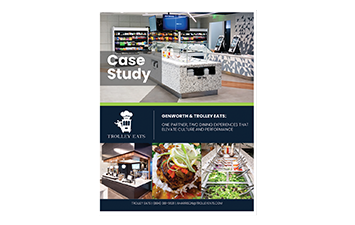Cooking Terms Explained
Did you know that there are entire books dedicated to defining and explaining culinary terms? With that many fancy words out there, restaurant menus can become so confusing that it can be difficult to understand exactly what you’re you’re going to receive. We went out and scoured the menus of local Richmond hot spots in search of commonly used, but minimally understood cooking terms. These explanations will have you ordering with confidence at your favorite restaurants in no time:
Aioli (Ey-oh-lee) : When it comes down to it, aioli is just freshly prepared mayonnaise with garlic. This sauce is often served alongside seafood or fried food for dipping, or used as a delicious spread on sandwiches. Flavored aiolis have become extremely popular, and at Groovin’ we make a few tasty variations, including blue cheese aioli, basil aioli, and chipotle aioli.
Charcuterie (Char-COO-ter-E): This is the French word for prepared meat products, and different types include sausage, pâté, bacon, ham, and confit. It was initially created through necessity as a means of preservation, but these days charcuterie is served for its delicious flavor which is developed through the preservation process.
Clarified butter: Clarified butter is butter void of any water or milk solids. It is translucent, golden-yellow in color, and absolutely delicious. In recipes where food is cooked at a high heat or for longer periods of time, clarified butter is much better than normal butter because it burns less easily.
Coulis (Coo-lee): Derived from the latin word meaning “to strain,” a coulis is a thick sauce made from strained fruit or vegetable puree. While vegetable coulis is often used as a base for sauces or stews, fruit coulis is often served as an accompaniment to dessert, as in Groovin’s chocolate ganache tortes; the richness from the molten chocolate center is perfectly complemented by a sweet, tart raspberry coulis.
Croquettes (Cro-kets): Basically anything coated in egg, breadcrumbs, and deep fried can be referred to as a croquette. Traditionally, croquettes have a potato base and are round in shape, and various meats and cheeses are added for flavor. Modern variations, however, are now made utilizing all kinds of unique ingredients. At Groovin’, for instance, we make smoked chicken and pork belly croquettes, and serve them with spiced apple maple broth and apple blossom. They’re fabulous for fall!
Emulsion (Em-ul-shun): An emulsion is a blended mixture of two substances that wouldn’t naturally blend together, like oil and vinegar. They can be temporary, meaning that they can come together and separate, or permanent, where they stay a homogenous, blended sauce. Balsamic vinaigrette is a temporary emulsion since it separates after just a few minutes, whereas hollandaise sauce is a permanent emulsion since it stays blended without repeated prompting.
Foie Gras (Fwa-grah): Praised by foodies and fancy chefs near and far, foie gras is simply the liver of fattened ducks or geese. This rich, buttery delicacy is most commonly seen canned, and it is normally served cold in pâté form as an appetizer. However, it is also delicious served fresh, pan seared, and smoking hot from the pan.
Ganache (Gah-nash): Used for filling, frosting, or as a sauce for desserts, this smooth, rich mixture of chocolate and cream is a third course staple. It is made by pouring warm cream over chopped chocolate, and for additional flavor, different extracts or liquors can be added. By varying the the ratio of chocolate to cream, chefs can achieve their desired consistency, but whether it’s made to be super thick as icing on a cake, or thin to use as a decorative sauce, it is incredibly delicious.
Gelée (Zhuh-lay) : As the name implies, a gelée is simply the French term for jelly, and it is typically made using fruit and gelatin. However, the thickness of gelées can vary, with some being the consistency of American jelly or jam, and more modern takes resembling jello or even gummy candy.
Pâté (Pat-ay): A pâté is a combination of cooked meat and various flavorings blended into a spreadable paste. It can be pureed to be smooth as butter, or chopped less finely and served on the chunkier side. Chicken liver is the most popular base, but all kinds of variations exist, including smoked salmon pâté, bacon pâté, and even pâté made using vegetables.
Sous vide (Soo-veed): This is a progressive cooking method where food is sealed in an airtight plastic bag, then cooked at low heat in a temperature regulated water bath. The intent is to cook the item at the temperature in which it will be served, typically between 130 and 140 degrees Fahrenheit. This ensures that the food cooks evenly, so it normally takes hours, and even days in some cases, to prepare. As an example, where a medium rare grilled steak is browned on the outside with a pink interior, a medium rare steak cooked sous vide would be an even medium pink all around.
Velouté (Vel-OO-tay): This fancy sounding French sauce is actually quite simple. It is basically a creamy white sauce, made using flour, butter, and stock. Normally, it serves as the foundation for more flavorful components to be added, such as lemon, white wine, tomato, or shallots, but all types of ingredients can be added to give it pizzazz. The lemon butter sauce on Groovin’s lemon butter chicken starts as a velouté, with lemon and a blend of fresh herbs added to create flavor.
Now, go out there with your head held high, your pronunciation on point, and order your next upscale meal with confidence and certainty.
Is there a term that you’re dying to have clarified that we didn’t include? Shoot us an email at food@groovingourmets.com and we’ll gladly give you an explanation.













